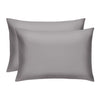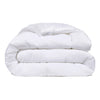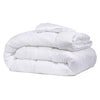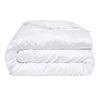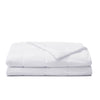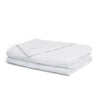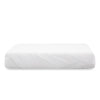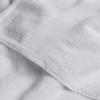The Daily Miracle
How To Remove Chocolate Stains
Published
December 16, 2023
Author
Bridget Reed

Have you ever found yourself savoring a delicious piece of chocolate, only to discover it's left a stubborn mark on your clothes or linens? It's a common scenario that can turn a moment of joy into a frustrating cleaning task.
But don't let these little accidents dampen your spirits! In this article, we'll guide you through removing chocolate stains effectively, combining our expertise with proven cleaning techniques. Whether it's a splash on your favorite shirt or a blot on your best sheets, we have you covered.
Why Are Chocolate Stains Challenging?
Delving deeper into the nature of chocolate stains reveals a complex interaction between the chocolate’s ingredients and fabric fibers. Cocoa contains natural oils and pigments, which, when combined with the fats and sugars in chocolate, create a compound that's sticky and prone to deeply penetrating fabric.
This complexity is exacerbated when the chocolate is warm and melts into the fibers, further entrenching the stain. Historically, the battle against such stains has been a part of household chores, paralleling the evolution of bedding and linens.
From the early days when straw and animal skins formed the first beds to the introduction of cotton and other natural fibers, the struggle against stains has been ever-present. This historical perspective underscores the perennial nature of the problem and highlights the remarkable progress in textile technology.
How Do I Pre-Treat Chocolate Stains?
Taking immediate action against chocolate stains is more of a science than one might think. When chocolate comes into contact with fabric, it begins a process of absorption that can be mitigated with prompt and proper treatment.
The goal during pre-treatment is to minimize the stain’s penetration and prevent it from bonding with the fabric fibers. This is where the texture and weave of the fabric play a crucial role.
Traditional fabrics may allow the stain to seep quickly, making removal more challenging. In contrast, our Miracle Brand fabrics, with their innovative weave and silver infusion, provide a first line of defense against deep-set stains.
The technique used in pre-treatment is as crucial as the timing. Scraping off excess chocolate should be done with utmost care. The method involves a delicate balance — removing as much chocolate as possible without spreading it further.
Blotting, rather than rubbing, is vital to prevent the stain from embedding deeper into the fabric. This step is about understanding how stains interact with fabrics at a microscopic level.
What Should I Use for Chocolate Stains?
Finding the right cleaning agents is critical in the battle against chocolate stains. Our Miracle Made Laundry Detergent Sheets are an excellent option for this task.
These environmentally friendly sheets pack a powerful punch against stains, ensuring deep cleaning while being gentle on both the fabric and your skin. Their hypoallergenic, toxic-free formula makes them suitable for all skin types, and their compact, lightweight design is perfect for storage and use.
Plus, their biodegradable packaging aligns with our commitment to sustainability, making them a responsible choice for environmentally conscious consumers.
Step-by-Step to a Clean Victory
Embarking on the journey of stain removal, especially with chocolate, involves a methodical approach that enhances the chances of restoring your fabric to its original state.
Let's delve deeper into each step to understand its importance and effectiveness.
1. Rinsing Under Cold Water
This initial step is crucial. Cold water helps solidify the fats in the chocolate, making it easier to remove the particles.
It's essential to rinse from the back of the fabric, as this method helps push the chocolate out rather than further into the fabric. This technique is based on the principle of flushing out the stain rather than embedding it deeper.
2. Miracle Made Laundry Detergent Sheets
These detergent sheets are specifically formulated to tackle tough stains while being gentle on fabrics. When you apply the detergent solution, it begins to interact with the chocolate particles.
The key here is to allow enough time for the detergent to penetrate and break down the chocolate's composition, which involves dissolving sugars and fats and loosening their grip on the fabric fibers.
3. Addressing Stubborn Stains
If the stain persists, additional mechanical action may be required. Rubbing the fabric gently or using a soft-bristled brush can aid in dislodging the chocolate particles from the fibers.
This step must be done with care to avoid damaging the fabric. The goal is to loosen the stain without being too abrasive.
4. Washing and Checking Before Drying
After treating the stain, washing the garment as per usual care instructions is next. However, checking that the stain has been completely removed before drying is imperative.
Heat from the dryer can set the stain permanently, making it a more formidable challenge to remove later. This step underscores the importance of thorough inspection post-wash.
Swapping out your home linens for our towels and bedding can also make this part of the process easier. Our Miracle Made Home Bundle is made from material infused with antibacterial silver, which means it resists odor and microbial growth longer.
This leads to longer spans of time between necessary washes, preserving the quality of your home linens, especially if you occasionally need to do some heavy-duty stain treatments.
Dealing With Stubborn Stains
When confronted with chocolate stains that have set over time, the approach needs to be more intensive yet cautious. Let's explore how to tackle these challenging stains without compromising the quality of your linens.
Household remedies, such as baking soda and vinegar, are not just old wives’ tales but backed by science. Baking soda, a mild alkali, works by breaking down acids in the stain, loosening its grip on the fabric. This process is gentle yet effective, making it a suitable choice for delicate fabrics.
Vinegar, on the other hand, is acidic and can dissolve the residues that alkaline cleaners may leave behind. It acts as a natural softener and helps in breaking down the stain's molecular bonds.
In applying these remedies, it's important to remember that moderation is key. Creating a paste of baking soda and water and applying it directly to the stain can be effective.
The paste should be allowed to sit for a few minutes to break down the stain before rinsing. Diluting vinegar with water and using it as a pre-wash treatment can help loosen the stain.
How Can I Prevent Chocolate Stains?
Preventing stains is always easier than removing them. Simple habits, such as using napkins while enjoying chocolate treats, can significantly reduce the risk of stains.
This means that even if you do encounter a spill, it's less likely to turn into a long-term problem. Regular maintenance of your linens is also essential. Timely laundering and proper storage can greatly extend the life and appearance of your fabrics, keeping them looking fresh and new for longer.
Sweet Treats and Sweeter Dreams
In conclusion, removing chocolate stains doesn't have to be a daunting task. With the right approach and products, you can tackle these stains with confidence. Our advanced linens and cleaning solutions at Miracle Brand are designed to make your life easier, allowing you to enjoy every chocolate moment without worry.
So go ahead, indulge in your favorite treats, and rest assured that your linens will remain as pristine as ever. Explore our range of innovative products and experience the perfect blend of luxury, innovation, and practicality for yourself.
Sources:
Antibacterial Silver | National Library of Medicine


